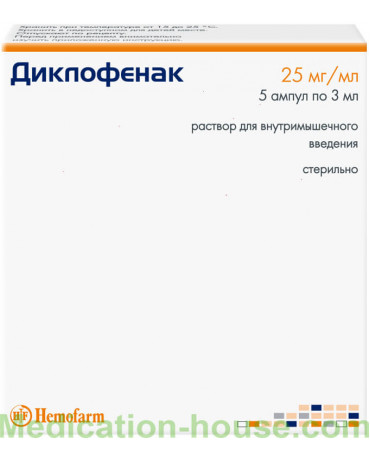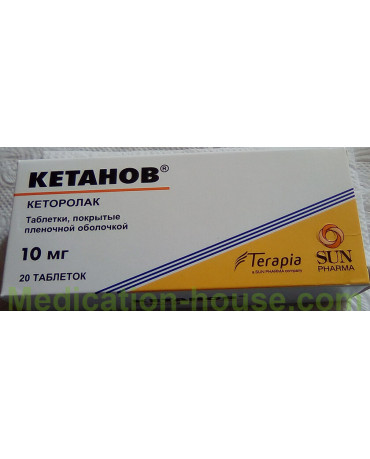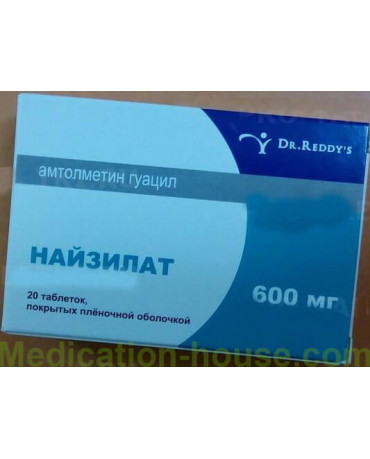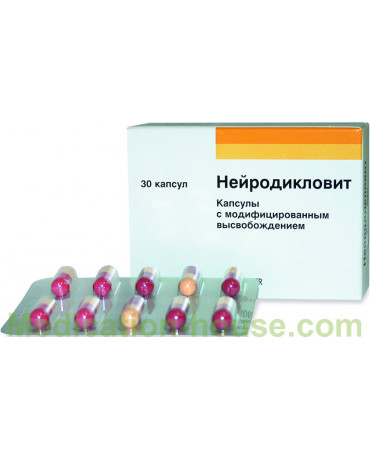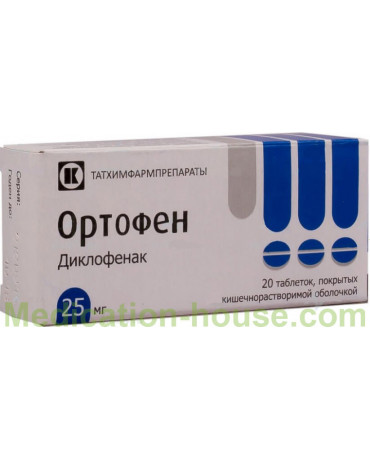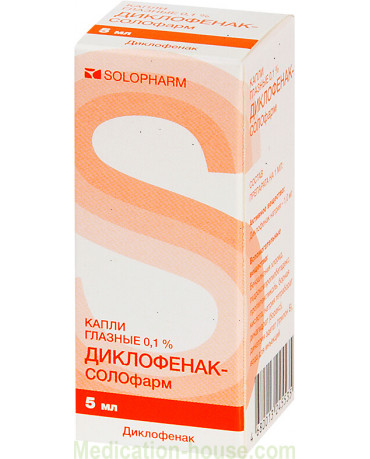Diclofenac user manual
Reed more and buy Diclofenac on this page
Release form and composition
Tablet forms: tablets in a c / p shell 25 mg, in p / o shell 25 and 50 mg, retard 100 mg.
Composition of the tablets in the enteric shell 25 or 50 mg Diclofenac sodium, dicalcium phosphate, starch, magnesium stearate, polyvinylpyrrolidone K30, talc purified, cellulose acetate, indorezin, diethyl phthalate, karmoizinovy varnish, titanium dioxide, Ponceau 4R varnish, iron oxide red and yellow .
Pharmacological effect
Suppresses the exudative and proliferative phases of inflammation. Reduces the amount of serotonin, histamine and bradykinin, increases the threshold of pain receptors perception; reduces the concentration of PG in the center of thermoregulation, increases heat transfer, reduces body temperature; inhibits platelet aggregation.
Indications for use
Diclofenac tablet form is prescribed to relieve pain in attacks of psoriatic, gouty, juvenile arthritis, ligament injuries and the knee joint system.
Tablets can be used for pain in the spine. Arising from osteochondrosis and degenerative changes in the intervertebral discs. It is used in the infringement of the sciatic and lumbar nerves, tunnel syndrome of the wrist or elbow joint. It is irreplaceable in case of injury, stretching or dislocation, including among athletes and people working in physically heavy industries.
Contraindications
Contraindications to the use of tablets:
inflammatory bowel disease;
exacerbation of gastrointestinal lesions (erosive and ulcerative);
bleeding from the digestive tract;
severe kidney or liver failure;
condition after coronary artery bypass surgery;
pregnancy and lactation;
"Aspirin Triad" - intolerance to NSAIDs in patients with bronchial asthma and nasal polyps;
children up to 6 years for 25 mg tablets, other dosages are contraindicated up to 18 years;
lactose intolerance, lactase deficiency, glucose-galactose absorption pathology.
It is prescribed with caution in the following conditions: inflammatory bowel disease, alcoholism, erosive and ulcerative gastrointestinal diseases chronic (without exacerbation), diabetes, diverticulitis, induced porphyria, bronchial asthma, anemia, congestive heart failure, edematous syndrome, hypertension, hepatic or renal failure , condition after serious surgical interventions, old age, systemic pathologies of connective tissue.
Use during pregnancy and lactation
Contraindicated in the III trimester of pregnancy. In the I and II trimester of pregnancy should be applied according to strict indications and in the smallest dosage.
Diclofenac penetrates into breast milk. If necessary, the appointment of the drug during lactation breastfeeding should be discontinued.
Instructions for use
The instructions for use indicate that Diclofenac in the form of tablets should be taken orally, without chewing and drinking plenty of water, preferably 30 minutes before a meal (to achieve a rapid therapeutic effect). It is also possible to take the drug before, during or after a meal.
Children from 15 years and adults Diclofenac is prescribed 2-3 times a day, 25-50 mg (maximum - 150 mg per day). After improvement, the dose is gradually reduced and transferred to maintenance therapy - 50 mg per day.
When treating juvenile rheumatoid arthritis, the daily dose can be increased to 3 mg / kg body weight.
For children, the drug is usually prescribed in the following doses (single / daily):
6-7 years (20-24 kg) - 25/25 mg;
8-11 years (25-37 kg) - 25 / 50-75 mg;
12-14 years (38-50 kg) - 25-50 / 75-100 mg.
How long can I use?
Most of the pathologies and complications associated with the use of this drug occur on the background of the duration of treatment. How to take Diclofenac tablets to prevent unpleasant symptoms? First of all, the process should be monitored by a doctor. Adult patients are prescribed 2-3 tablets per day. The dose decreases with the onset of improvements.
Duration of admission should not exceed 2 weeks, except in difficult cases.
Side effects
When taken orally, the following side effects are possible: dyspeptic symptoms, erosive and ulcerative lesions of the alimentary canal, perforation of its walls, gastric and intestinal hemorrhages, increased drowsiness, dizziness, hypersensitivity reactions, irritability.
Overdose
Symptoms: hypotension, renal failure, convulsions, gastrointestinal irritation or respiratory depression are possible.
Treatment: there is no specific antidote. In case of acute poisoning, it is necessary to stop the absorption of the drug from the gastrointestinal tract as soon as possible. It is shown gastric lavage, the appointment of activated carbon and the conduct of other symptomatic and supportive therapy. The use of forced diuresis, dialysis or blood transfusion is hardly justified due to the fact that NSAIDs are largely associated with serum proteins and have an extensive metabolism.
special instructions for Diclofenac
During the period of drug treatment should be carried out systematic monitoring of peripheral blood, liver, kidney, feces for the presence of blood.
Patients taking the drug should refrain from activities that require increased attention and quick mental and motor reactions, alcohol consumption.
Drug interactions
Reduces the effect of hypoglycemic agents.
Reduces the effects of hypotensive and hypnotic drugs.
Acetylsalicylic acid reduces the concentration of diclofenac in the blood.
Increases plasma concentration of digoxin, methotrexate. lithium and cyclosporine drugs.
Simultaneous use with paracetamol increases the risk of the development of the nephrotoxic effects of diclofenac.
Cefamundol, cefoperazone, cefotetan, valproic acid and plykamycin increase the incidence of hypoprothrombinemia.
Cyclosporine and gold preparations increase the effect of diclofenac on the synthesis of prostaglandins in the kidneys, which increases nephrotoxicity.
The simultaneous appointment with ethanol, colchicine, corticotropin and St. John's wort preparations increases the risk of bleeding in the gastrointestinal tract.
Reduces the effect of diuretics, against the background of potassium-sparing diuretics increases the risk of hyperkalemia; against the background of anticoagulants, thrombolytic agents (alteplaza, streptokinase, urokinase) - the risk of bleeding (usually from the gastrointestinal tract).
Diclofenac enhances the effect of drugs that cause photosensitization. Drugs that block tubular secretion, increase the concentration in diclofenac plasma, thereby increasing its toxicity.
Increases the likelihood of side effects of other NSAIDs and glucocorticosteroid drugs (bleeding in the gastrointestinal tract), the toxicity of methotrexate and cyclosporine nephrotoxicity.
Reviews
We picked up some reviews of people about Diclofenac tablets:
Irina
I have arthritis and gout. Once a doctor prescribed to drink Diclofenac pills. Symptomatology removes very badly, the pain practically did not disappear, the swelling of the joints and stiffness remained. Moreover, the stomach is also badly affected. Waking up in the morning after taking it, I noticed that my stomach was swollen, I was a little sick, and there was mild nausea. After reading the instructions, I realized that the side effects of the drug are much greater than the healing properties. In the future, I did not take this medicine. The doctor found a suitable alternative.
Tatyana
Diclofenac is a widely used analgesic and anti-inflammatory agent. My husband and I were often prescribed this drug in a different dosage form, when pains in my back and joints worried me. The medicine quickly relieves pain, but when long-term treatment is prescribed, the gastrointestinal tract suffers. Therefore, we refrain from taking it as much as possible and choose more benign medications.
Anatoly
With serious chronic diseases, these pills will not be able to cure, they will only remove the symptoms. I have a chronic disease. I accept on average once a year, most often by this time pain in the joints, stiffness in the morning and swelling already appear. In general, a good drug, inexpensive.
Storage conditions and shelf life
Store the preparation in a dry, dark place, out of the reach of children, at a temperature not exceeding 25 ° C.
Shelf life - 3 years. Do not use after the expiration date printed on the package.
Terms of sell
You don't need a prescription to buy Diclofenac.


